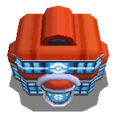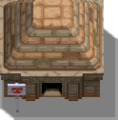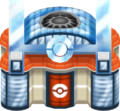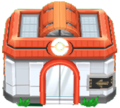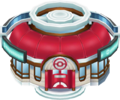Pokémon Center: Difference between revisions
| Line 22: | Line 22: | ||
Prior to {{game|HeartGold and SoulSilver|s}}, Pokémon Centers had slogans: in Generation, I, II, [[Kanto]]-based Generation III, and [[Sinnoh]]-based [[Generation IV]] games, it is "Heal Your Pokémon!"; in the [[Hoenn]]-based Generation III games, it is "Rejuvenate your tired partners!" | Prior to {{game|HeartGold and SoulSilver|s}}, Pokémon Centers had slogans: in Generation, I, II, [[Kanto]]-based Generation III, and [[Sinnoh]]-based [[Generation IV]] games, it is "Heal Your Pokémon!"; in the [[Hoenn]]-based Generation III games, it is "Rejuvenate your tired partners!" | ||
The ''Pokémon Center'' theme has remained essentially the same throughout the generations. It is notably different at [[Time|nighttime]] in {{game2|Diamond|Pearl|Platinum}}. A rearrangement has also been used in [[Super Smash Bros. Brawl]]. | The ''Pokémon Center'' theme has remained essentially the same throughout the generations. It is notably different at [[Time|nighttime]] in {{game2|Diamond|Pearl|Platinum}}. A rearrangement has also been used in [[Super Smash Bros. Brawl]] and every Smash game after that. | ||
[[File:Pokémon Center inside RBY.png|thumb|left|A Pokémon Center in the [[Generation I]] games]] | [[File:Pokémon Center inside RBY.png|thumb|left|A Pokémon Center in the [[Generation I]] games]] | ||
Revision as of 18:13, 31 October 2020
- If you were looking for the retail store chain, see Pokémon Center (store).

A Pokémon Center (Japanese: ポケモンセンター Pokémon Center), also shortened to PMC in Pokémon Sun and Moon or Pokécen or Pokésen (Japanese: ポケセン) in Japan, is a type of building that provides regulatory services for Pokémon Trainers. Pokémon Centers are found in most towns and cities of the Pokémon world; every major city or town holds a Pokémon Center. Some Pokémon Centers can be found outside of towns next to large forests or caves. Pokémon Centers are built where many Trainers gather and the area becomes popular. This is to accommodate those Trainers in need and serve as a resting spot. The most common service the Pokémon Center offers is healing Pokémon free of charge.
In the games, Pokémon Centers consist of a healing station run by a Pokémon Center Nurse, a PC, a trading connection club, a battling connection club (neither of which require wired connections as of Pokémon FireRed and LeafGreen), and various NPCs that vary upon location (in rural areas, no NPCs may be present). As of Generation V, salesmen from the Poké Mart and the deliveryman (in Generation V and VII) or delivery girl (in Generation VI) appear when the Mystery Gift function is activated, due to its integration with the Pokémon Center. Mr. Medal also appears here in Pokémon Black 2 and White 2 when awarding the player any Medals. The connection clubs are absent in Generation VI and are replaced with the Player Search System.
Fly, Charizard Glide, Sky Dash, and the Flying Taxi bring the player to the Pokémon Center in the town or city chosen, and Teleport brings the player to the Pokémon Center they last visited (or to the Pokémon Center of the city or town they are currently in). Also, if defeated in battle, the player will appear at the Pokémon Center most recently visited (unless the player has not visited a Pokémon Center, in which case the player will appear outside his or her home).
In the core series games
Pokémon Centers are important buildings in the games and are found in most towns and cities, sometimes even on routes. Pokémon Centers are essential to Trainers as they provide many facilities and host most game mechanics. Non-player character Trainers and their own Pokémon are often found hanging around in Pokémon Centers, offering general advice and information on the events in the town or area it is situated in. Though the setup of the Pokémon Centers has varied slightly throughout each generation, all Pokémon Centers have the same core functions:
- A Pokémon Center Nurse heals all party Pokémon in a matter of seconds. This service heals all status conditions and recharges HP and PP of all party Pokémon, free of charge. The nurse is located at the main counter just as the player enters the Pokémon Center.
- Trainers also have access to a PC so that they can change out their party. Players are able to deposit and withdraw Pokémon, along with the ability to store and withdraw items and display their Hall of Fame details.
Until Generation V, Pokémon Centers also hosted the Cable Club or the Union Room, which facilitated multiplayer gameplay. Originally, linked players could only battle and trade with one another, but in later generations, players could mix recordsRSEDPPtHGSS and play gamesPtHGSS together.
In the Generation I, II and III games, saving inside a Pokémon Center is required to facilitate linking with console games such as Pokémon Stadium and Pokémon Colosseum.
Prior to Pokémon HeartGold and SoulSilver, Pokémon Centers had slogans: in Generation, I, II, Kanto-based Generation III, and Sinnoh-based Generation IV games, it is "Heal Your Pokémon!"; in the Hoenn-based Generation III games, it is "Rejuvenate your tired partners!"
The Pokémon Center theme has remained essentially the same throughout the generations. It is notably different at nighttime in Pokémon Diamond, Pearl, and Platinum. A rearrangement has also been used in Super Smash Bros. Brawl and every Smash game after that.

Generation I
In the Generation I games, a Pokémon Center consists of two counters on a single floor. The counter on the left has a Pokémon Center Nurse that will heal the player's Pokémon. The counter on the right contains the Cable Club, which allows players to link with each other. Talking to the women at the desk will allow the player to enter the Cable Club. Furthest to the right is the PC to deposit and withdraw Pokémon or items. The Generation I games also include two of the few examples of a Pokémon Center that isn't in a town: the Pokémon Centers in Route 4, outside Mt. Moon, and in Route 10, outside the entrance to the Rock Tunnel. Future generations employ rest houses that only offer healing services in similar areas.
In Pokémon Yellow, a Chansey stands beside the nurse in every center. This is a reference to Nurse Joy in the anime.
Cable Club
The Cable Club (Japanese: つうしん ケーブル クラブ Communication Cable Club) is the original link-up place, it is located at the far end of the Pokémon Center in Generation I Kanto. Players can link together to simply battle each other one-on-one and trade Pokémon with each other. Two players linked by a Game Boy Game Link Cable can enter the Cable Club. Pokémon Yellow features an extended version of the Cable Club with the option to choose special battle rules or cups.
Generation II

In the Generation II games, to accommodate greater linking functionality, the Pokémon Centers of both Kanto and Johto expanded to two floors. On the first floor, there is the counter where a Pokémon Center Nurse heals the player's Pokémon, as well as a PC. On the second floor resides the Cable Club and Time Capsule.
In the Japanese versions and Korean versions of Pokémon Gold and Silver, the sign of Johto's Pokémon Centers have a Poké Ball logo and the letters PC while Kanto's use the same sign as that of the Generation I games. In the localized versions, the Generation I sign was used for both regions.
Cable Club
Located upstairs in Pokémon Centers throughout Johto and Kanto, this Cable Club consists of three rooms. The Cable Club Trade Center facilitates trading, the Cable Club Colosseum allows battling, and the Cable Club Time Capsule provides a way to trade Pokémon with the Generation I games. Because there were no female protagonists prior to Kris's introduction in Pokémon Crystal, a player who has chosen Kris is temporarily swapped into the male player sprite before linking with a Generation I game or with Pokémon Gold and Silver; this is still the case for two Pokémon Crystal games linked with each other, despite the sprite data for the female choice being present.
Two players can enter the Cable Club with a Game Boy or Game Boy Color Game Link Cable.
PokéCom Center
- Main article: Pokémon Communication Center
Exclusively in the Japanese version of Pokémon Crystal, the Pokémon Communication Center, or PokéCom Center, replaces the regular Pokémon Center in Goldenrod City, and takes use of the Pokémon Mobile System GB. It is in essence a prototype for the Global Terminal, justifying the placement of one in the city in Pokémon HeartGold and SoulSilver.
Generation III

|
This section is incomplete. Please feel free to edit this section to add missing information and complete it. Reason: Colosseum and XD details |

Pokémon Centers in the Generation III games keep the two-floor setup, similar to the regular Pokémon Centers in the Generation II games. The only difference is that the stairs to the second floor are larger and more noticeable, taking the shape of an escalator.
In Orre, there are only three official Pokémon Centers, located in Phenac City, Agate Village, and Gateon Port, all of which have unique appearances. Only the Phenac City Pokémon Center has facilities for linking with the Generation III core series games. Self-service healing machines, identical to ones staffed by a nurse in a Pokémon Center, appear scattered throughout Orre, usually next to a PC.
In Pokémon Colosseum and Pokémon XD: Gale of Darkness, when trading with a core series game, the trade is conducted entirely through the Pokémon Colosseum interface. However, the core series game must be saved inside a Pokémon Center in order to be able to trade with the GameCube game.
2F
The second floor of the Pokémon Center includes various communication hubs.
In Pokémon Ruby and Sapphire, Pokémon Center 2F is the Pokémon Cable Club. It has three communication rooms: the Pokémon Cable Club Trade Center, Pokémon Cable Club Colosseum, and Pokémon Cable Club Record Corner.
In Pokémon FireRed, LeafGreen, and Emerald, Pokémon Center 2F has an attendant's desk and two communication desks: the Union Room and the Direct Corner. Teala, the attendant, explains the communication functions to the player. The Union Room is a wireless hub for multiple players that requires the Game Boy Advance Wireless Adapter to enter. The Direct Corner transitions between the Pokémon Wireless Club Direct Corner (if the Wireless Adapter was connected when launching the game) or the Pokémon Cable Club (if it was not); the Pokémon Cable Club uses the Game Link Cable while the Pokémon Wireless Club Direct Corner uses the Wireless Adapter. The Pokémon Cable Club Direct Corner has the same features as the Pokémon Cable Club in Pokémon Ruby and Sapphire, but these are all accessed from the same desk.
Pokémon Cable Club
The Pokémon Cable Club is a set of communication features in all Generation III core series games that use a Game Link Cable. In Pokémon Ruby and Sapphire, the entire floor is the Pokémon Cable Club, with each feature having its own desk; in Pokémon FireRed, LeafGreen, and Emerald, they are all accessed from the Direct Corner desk, as long as the Wireless Adapter is not connected.
- In the Trade Center, the player can trade Pokémon with one other player. There are no restrictions on trading between languages.
- In the Colosseum, the player can battle one other player in a Single or Double Battle, or join three other players for a Multi Battle. There are no restrictions on battling between languages. Link battle wins and losses are recorded on the Battle Results board on Pokémon Center 2F.
- In the Record Corner, the player can mix records with up to three other players of Pokémon Ruby, Sapphire, or Emerald. The player must have reached the Mauville City Pokémon Center in order to mix records. This feature is not available in Pokémon FireRed and LeafGreen. Japanese Pokémon Ruby and Sapphire cannot mix records with non-Japanese games, and non-Japanese Pokémon Ruby and Sapphire cannot mix records with Japanese games; otherwise, there are no restrictions on mixing records between languages.
Pokémon Wireless Club
The Pokémon Wireless Club is a set of communication features in Pokémon FireRed, LeafGreen, and Emerald that use the Game Boy Advance Wireless Adapter. There are two desks that form this club: the Union Room and the Direct Corner.
Pokémon Wireless Club Direct Corner
The Pokémon Wireless Club Direct Corner is accessible at the Direct Corner if the Wireless Adapter was connected when the game was launched. It has four features in Pokémon Emerald and three in Pokémon FireRed and LeafGreen. This club only allows communication among these three games.
- In the Trade Center, the player can trade Pokémon with one other player. There are no restrictions on trading between languages.
- In the Colosseum, the player can battle one other player in a Single or Double Battle, or join three other players for a Multi Battle. There are no restrictions on battling between languages. Link battle wins and losses are recorded on the Battle Results board on Pokémon Center 2F.
- In the Record Corner, the player can mix records with up to three other players of Pokémon Emerald. The player must have reached the Mauville City Pokémon Center in order to mix records. This feature is not available in Pokémon FireRed and LeafGreen. There are no restrictions on mixing records between languages in the Wireless Club.
- In Berry Crush, the player can play the Berry Crush minigame with another player. The Powder Jar is required to play this minigame.
When using the Pokémon Wireless Club Direct Corner, one player must choose "Become Leader", while the other players choose "Join Group" and join that leader's group.
Union Room

|
This section is incomplete. Please feel free to edit this section to add missing information and complete it. Reason: Language restrictions on the Union Room (if any) |
The Union Room is accessible at the Union Room desk, but only if the Wireless Adapter was connected when the game launched. The Union Room is a special hub area in which nearby players who are also in the Union Room appear. Up to 40 players can appear in the room at once.
In the Union Room, players can chat using the easy chat system, view other Trainers' Trainer cards, battle with up to three level 30 or lower Pokémon, or trade via the trading board.
Generation IV

In the Generation IV games, Pokémon Centers introduce a basement floor, which takes use of Nintendo Wi-Fi Connection. Opposite the ground floor's escalator, another escalator downstairs to the basement appears. While the second floor retains the same features from the Generation III games, supporting up to four players using the native wireless connection of the Nintendo DS, the basement floor is where players can link up with others around the world using Nintendo Wi-Fi Connection. The ground floor, as always, is where a player can heal their Pokémon and use a PC. As of Pokémon Platinum, players can also challenge other Trainers inside specific Pokémon Centers also in Pokémon HeartGold and SoulSilver in Olivine City.
In Pokémon HeartGold and SoulSilver, the Pokémon Center's design receives a major overhaul. The second floor became a mezzanine, located above and directly behind the main desk, and two staircases were added on each side of the desk for access to it. The PC was moved to the corner of the desk. All functions remain the same. The player's walking Pokémon will return to its Poké Ball while being healed. If the first Pokémon in the player's party fainted prior to healing, it will return to being the walking Pokémon as soon as it has been revived.
A healing machine similar to the ones found in the centers can be obtained from the Underground in Pokémon Diamond, Pearl, and Platinum and placed in a Secret Base; however, it cannot heal Pokémon.
Wireless Club
Both Sinnoh and Generation IV Johto feature a wireless club just like Hoenn and Generation III Kanto, where players in a Union Room can battle, trade, mix records and, in Pokémon Platinum and Pokémon HeartGold and SoulSilver, spin Eggs. However, the Pokémon Centers in these regions also have a basement, where the Wi-Fi Club is located, allowing players to connect to each other if they are registered on each other's Pal Pad. Here they can battle and trade, and they can talk to each other through the built-in microphone of the Nintendo DS, instead of using the easy chat system as in the Generation III games; however, the easy chat system is also supported.
Wi-Fi Plaza
- Main article: Wi-Fi Plaza
The Wi-Fi Plaza is an enhancement to the Wi-Fi Club in Pokémon Platinum and Pokémon HeartGold and SoulSilver and is located on the basement floor. Players from around the world can enter a plaza to make Poffins and play minigames together via Nintendo Wi-Fi Connection. The player can walk around the plaza and communicate with other players there. A leap in multiplayer gameplay is introduced, allowing up to twenty players to enter the Wi-Fi Plaza at a time. The player may only spend a certain amount of time at the Wi-Fi Plaza each day.
Generation V

In the Generation V games, the Poké Mart has been merged with the Pokémon Center. This is similar to how the Pokémon League lobbies of previous generations contain both a Poké Mart and a Pokémon Center. The PCs in this generation have a help function, which describes a wide variety of game-related topics.
As with Pokémon HeartGold and SoulSilver, the second floor is a mezzanine above and directly behind the main desk. All multiplayer features found on the second floor of Pokémon Centers in the Generation IV games, including the Nintendo Wi-Fi Connection features present in the basements, can be found here by talking to the attendant to the left and on the center, respectively. The attendant to the right allows players to access the Global Trade System (GTS), as well as all the features from the Global Terminal, such as the playback of recorded videos. The Global Battle Union (GBU) can also be accessed here, allowing players to battle random players via Nintendo Wi-Fi Connection. The Geonet can also be found on the second floor, allowing players to register their real-world location, as in the Generation IV games. All Pokémon Centers except the one in the Pokémon League have a second floor.
Generation VI

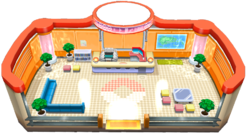
In Generation VI, the wireless and online features previously accessible in Pokémon Centers are now handled by the Player Search System. As a result, the Centers are much smaller, as there is no need for additional floors anymore.
In Pokémon X and Y, the Pokémon Centers now consist of the traditional counter to heal the player's Pokémon, and two small rooms to the sides. The room located on the right of the counter houses the Poké Mart again, which is accessed by talking to an attendant. In certain towns, a second attendant who sells TMs, special types of Poké Balls, or other items is also present. The room to the left of the counter is a dressing room that allows the player to change clothes and register their favorite outfits.
In Pokémon Omega Ruby and Alpha Sapphire, the Pokémon Centers have a similar layout to the ground floor of the Pokémon Centers of the original versions. Also, the Pokémon Center in Lavaridge Town is connected to the town's hot springs.
If the player walks into a Pokémon Center on their birthday (as noted in the 3DS system), the nurse will wish them a happy birthday.
Generation VII

In Generation VII, Pokémon Centers consist of one large room. The nurse's counter is in the center of the building. On the right is a Poké Mart counter, staffed by one or two attendants depending on the Pokémon Center. On the left is the Pokémon Center Café, where players can purchase one of three drinks. Once per day, after buying a drink, the player will receive Poké Beans for use in Pokémon Refresh and a status condition healing item from another region, such as Casteliacones and Old Gateaux.
Generation VIII

In Generation VIII, Pokémon Centers consist of one large room. The nurse's counter is in the center toward the back of the Pokémon Center. The nurse will heal all of the Pokémon in the player's party and Boxes. On the right is a Poké Mart counter, staffed by one or two attendants depending on the Pokémon Center. The range of items available for purchase at Poké Marts expands as the player earns more Gym Badges. Behind the left counter is an Indeedee and an attendant who serves as the Move Deleter, Move Reminder, and Name Rater. There is also a Rotomi next to the nurse's counter.
Layout

|
This section is incomplete. Please feel free to edit this section to add missing information and complete it. Reason: Interior |
Exterior
Red and Blue
KantoYellow
KantoGold, Silver and Crystal
KantoGold, Silver and Crystal
Cherrygrove CityGold, Silver and Crystal
Violet City and Route 32Gold, Silver and Crystal
Azalea TownGold, Silver and Crystal
Goldenrod CityGold, Silver and Crystal
Ecruteak CityGold, Silver and Crystal
Olivine CityGold, Silver and Crystal
Cianwood CityGold, Silver and Crystal
Mahogany TownGold, Silver and Crystal
Blackthorn CityRuby, Sapphire and Emerald
HoennFireRed and LeafGreen
KantoFireRed and LeafGreen
Pokémon Network CenterDiamond, Pearl and Platinum
SinnohHeartGold and SoulSilver
Violet City and Ecruteak CityBlack, White, Black 2 and White 2
UnovaBlack 2 and White 2
Victory RoadX and Y
KalosOmega Ruby and Alpha Sapphire
HoennSun, Moon, Ultra Sun, and Ultra Moon
Alola- Pokemon Center SwSh.png
Sword and Shield
Galar
Exterior (Japan)
Gold, Silver and Crystal
Cherrygrove CityGold, Silver and Crystal
Violet City and Route 32Gold, Silver and Crystal
Azalea TownGold and Silver
Goldenrod CityGold, Silver and Crystal
Ecruteak CityGold, Silver and Crystal
Olivine CityGold, Silver and Crystal
Cianwood CityGold, Silver and Crystal
Mahogany TownGold, Silver and Crystal
Blackthorn City
In the spin-off games
Pokémon Puzzle League
In Pokémon Puzzle League, the Puzzle Village contains a Pokémon Center building which simply displays the options screen.
Pokémon Pinball: Ruby & Sapphire
- Main article: Pokémon Mart and Pokémon Center (Ruby Field)
In the Ruby Field of Pokémon Pinball: Ruby & Sapphire, the same building serves as a Pokémon Mart and Pokémon Center. When this building serves as a Pokémon Center, it is used to evolve Pokémon. The "Pokémon Mart" sign turns around and becomes a "Pokémon Center" sign when a Pokémon is able to evolve.

|

|
| Pokémon Center (closed door) |
Pokémon Center (open door) |
Pokémon Trading Card Game series
In Pokémon Trading Card Game and Pokémon Card GB2: Here Comes Team GR!, there is no Pokémon Center. However, the Clubs in the TCG Island and Forts in the GR Island have a room at the west side that is visually similar to the interior of Pokémon Centers, which include a PC and female attendants that offer multiplayer features: the Battle Center for dueling and the Gift Center for transferring cards and deck configurations.
The Pokémon Center card is available in both games.
| Pokémon Center (GB1) | Pokémon Center (GB2) |
In the anime
In the main series
Pokémon Centers in the anime are headed by a Nurse Joy. The healing process takes place in real-time, unlike in the games, so Ash and his friends often have to wait until their Pokémon are fully healed. All Pokémon Centers are connected and, in times of crisis, all Pokémon can be transferred from one to another, as seen in Pokémon Emergency!. Pokémon Centers are considered an important service, as shown in Celebi and Joy! where, in the past, the residents of Marion Town built a Pokémon Center as a community project.
Pokémon Centers are designed for Trainers so they can rest between activities. Trainers use Pokémon Centers as gathering places, so they can share information about Pokémon. They also have access to video phones, PCs, trade machines, and most offer free food and lodging. As a Pokémon journey can take a long time, Pokémon Centers can also be used as mailing destinations. In addition, a Trainer can arrange for their loved ones to send them packages, typically to the next Pokémon Center they are traveling to.
Inside a typical Pokémon Center, one can find a front desk, a lobby (sometimes with vending machines), a Poké Ball room, an Emergency Room with plenty of beds for injured Pokémon, a recovery room, a waiting room, rooms for lodging, and a cafeteria. A lobby may also have a large widescreen TV or several smaller TVs so Trainers can watch typically Pokémon-oriented shows, such as Sinnoh Now, Pokémon Contest broadcasts, and major competitions like the Pokémon League Conference and the Grand Festival of each region. A typical sleeping room has a desk and chair and two sets of bunk beds to maximize space and girls do not have to sleep in separate rooms from boys. At least one Pokémon Center was shown in Uncrushing Defeat! to have a small library with a PC (presumably connected to some network akin to the Internet), as an information room. It is unknown how these activities performed by a Pokémon Center are financed. On the outside, they come in all shapes and sizes, but usually have a rather large P somewhere and battlefields where Trainers can practice.
As shown in The Ghost of Maiden's Peak, Pokémon Centers have a curfew for their residing Trainers. At 11:00 PM a metal screen is lowered down in front of the Pokémon Center's doorway, preventing Trainers from entering or leaving the Pokémon Center after curfew.
The resident Nurse Joy of the center is usually assisted by a certain type of Pokémon, usually one or various Chansey in Kanto, Johto, Hoenn, Sinnoh, and the Orange Archipelago, Audino in Unova and the Decolore Islands, Wigglytuff in Kalos, and Blissey and Comfey in Alola. There are some exceptions in certain Pokémon Centers regardless of region however, for example the Nurse Joy of Johto's Ice Path was assisted by a Jynx.
Professor Oak has also written senryū about Pokémon Centers in two of his lectures:
- For Dawn of a New Era!, the Professor Oak's Big Pokémon Encyclopedia segment featured the senryū "When I want to meet Nurse Joy, Pokémon Center." (Japanese: 「ジョーイさん あいたくなったら ポケモンセンター」)
- For Saving Darmanitan From the Bell!, the Professor Oak's Pokémon Holo Caster segment featured the senryū "Nurse Joy, Pokémon Center, without a break." (Japanese: 「ジョーイさん ポケモンセンター やすみなし」)
Pokédex entries
|
In Pokémon Origins
In Pokémon Origins, Pokémon Centers are headed by an unnamed Nurse. The healing process takes place in real time, unlike in the games, which would often make Red wait until his Pokémon were fully healed before leaving. Pokémon Centers can also be used as social gathering places where Trainers can share information with other people. Additionally, Trainers have access to video phones and PCs within the Pokémon Center.
In the manga
In the Be the Best! Pokémon B+W manga
A Pokémon Center appeared in Victini - A New Friend!. Monta received a Victini from a deliveryman there.

In the movie adaptations
A Pokémon Center located in Dahara City appeared in Hoopa and the Clash of Ages.
In the Pokémon Adventures manga
One of the Pokémon Centers first appeared in Wanted: Pikachu!.
In the Pokémon Pocket Monsters manga
One of the Pokémon Centers first appeared in Big Battle in the Viridian Forest!!. Another one appeared in Great Success in the Mountains or the Seas!? and PMDP15.
In the TCG
The following is a list of cards named Pokémon Center.
| Pokémon Center Cards listed with a blue background are only legal to use in the current Expanded format. Cards listed with a green background are legal to use in both the current Standard and Expanded formats. | |||||||
|---|---|---|---|---|---|---|---|
| Card | Type | English Expansion |
Rarity | # | Japanese Expansion |
Rarity | # |
| Pokémon Center | T | Base Set | 85/102 | Expansion Pack | |||
| Nivi City Gym | |||||||
| Yamabuki City Gym | |||||||
| Base Set 2 | 114/130 | ||||||
| Wizards Black Star Promos | 40 | ||||||
| Night Pokémon Center | T | Diamond & Pearl | 108/130 | Space-Time Creation | |||
| Pokémon Center | St | Next Destinies | 90/99 | Hail Blizzard | 051/052 | ||
| BW-P Promotional cards | 190/BW-P | ||||||
In the TFG
The playmat in the Pokémon Trading Figure Game has a Pokémon Center space, which Pokémon are sent to if they lose a battle.
Trivia
- In Capsule Monsters, Trainers restored their monsters' health by staying at inns and hotels, which provided healing devices in rooms.[1] This might explain the similarities between Pokémon Centers and the Celadon Hotel in the Generation I games.
- The Rest Houses in the Eastern side of Center Area along with the ones in Area 2 and Area 3 of the Safari Zone in the Generation I games also have leftovers of Pokémon Center design: in the Japanese Pokémon Red, Green, and Blue, the houses trigger hidden text in the same coordinates as the couch guy at Pokémon Centers, while inaccessible PCs are placed outside the boundaries of the map but in the same coordinates as PCs in Pokémon Centers (the PCs are also in the Western Pokémon Red and Blue; both texts and PCs, including the invisible Celadon Hotel PC, were completely removed in Japanese and Western Pokémon Yellow). Additionally, the tileset data of the Safari Zone maps includes tiles with the Pokémon Center signpost for use in the Rest Houses, without any text. Unlike Pokémon Centers, however, which store the player's current location in memory so that Teleport, Dig, or Escape Ropes return the player to the last location with a Pokémon Center available, the Safari Zone's Rest Houses are intentionally programmed to prevent this behavior so that the player does not cheat the Safari Game.
- The Pokémon Center in Po Town is the only one in the core series where healing one's Pokémon is not free of charge, as the Team Skull Grunt behind the desk will charge the player $10.
In other languages
| |||||||||||||||||||||||||||||||||||||||||||||||||||||||||||||||||||||||||||||||||
See also
References

|
This article is part of Project Locations, a Bulbapedia project that aims to write comprehensive articles on every location in the Pokémon world. |





















